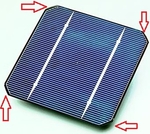In the battle for efficiency of solar panels, there are many contenders.
The bar is constantly being raised as new records are set in the lab and in the real world. To keep things interesting, there are also several types of solar panels available, each with their own efficiency standards.
Let’s break down the efficiency levels you can expect from different solar cell technologies and ask the $64 000 question you may not have considered:
Does solar panel efficiency even matter?
Before we get to that head-scratcher, however, let’s separate our solar panel contenders into two different weight categories (figuratively speaking).
In the heavyweight category we have crystalline solar panels which have always led the way in efficiency. (These panels also tend to cost a little more).
In the welterweight category we have thin film solar panels which aren’t quite as efficient (but get great marks in the price department).
Crystalline solar panels are made using crystalline silicon solar cells. The efficiency of solar panels using multicrystalline solar cells fall in the efficiency range of 14% to 19%. This can be even higher for monocrystalline solar cells as demonstrated by SunPower solar panels reaching efficiencies of 24.2%.
What is the difference between monocrystalline and multicrystalline solar cells? They have different manufacturing processes.
Monocrystalline cells are cut from cylindrical ingots while multi or polycrystalline cells are made from cast square ingots.
The single crystal cylindrical ingot process is more labor intensive (and expensive) than filling a square ingot with molten silicon. You can tell which solar modules are monocrystalline because they have “gaps” in the corner of the cells due to their production method.

Thin film solar panels include some different technologies but, as mentioned previously, they tend to have lower efficiencies than their crystalline cousins. Varieties of thin film modules include.
- Amorphous silicon
- Amorphous silicon solar cells like those found in Unisolar laminates and Kaneka solar panels have an efficiency of around 6%.
- Copper indium gallium (di)selenide (CIGS)
- The now-defunct Solyndra used CIGS technology in a unique “solar tube” design to achieve efficiencies of 12% to 14%. Nanosolar recently announced 13.9% efficiency for its printed CIGS solar cells.
- Cadmium Telluride
- The cadmium telluride panels of First Solar have reached a module efficiency of 11.3%.
Now that you’ve got a general idea about who comes out on top with regard to the efficiency of solar panels, let’s get back to the big question:
Does solar panel efficiency really matter?
The main factor in determining whether solar efficiency should be important to you is the amount of space you have available for a solar installation.
If you have limited roof space, higher efficiency panels will allow you to produce more power than you could otherwise.
If, however, the limiting factor in your solar installation is not roof space but rather the cost of the installation or the size of the installation in kilowatts, module efficiency might not be such a big deal.
In my province of Ontario, for instance, there is a government feed-in-tariff that pays 54.9 cents per kilowatt hour of electricity produced by any rooftop solar installation of 10 kilowatts or less.
If you had enough money and plenty of roof space for a 10 kilowatt installation, the efficiency of the solar panels wouldn’t really matter too much.
What you would probably be more concerned about is the cost per watt. If you could fit a 10 kilowatt amorphous silicon system on your roof for less money than a 10 kilowatt monocrystalline system, why would solar cell efficiency matter?
After all, the amorphous silicon system will be generating a similar amount of power and the only downside will be that it takes up more space on your roof (which you probably weren’t using anyway).
So be sure to take a look at all of the information on efficiency of solar panels when researching your solar installation but also understand that efficiency might not be the most important factor.
Cost per watt and overall quality will always play a big role in the success of your solar rooftop.
